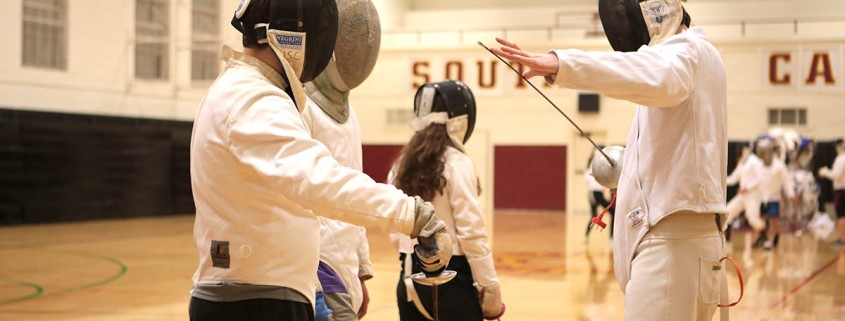Fencing club preserves unique tradition
The clash of metal echoes through the gymnasium of the Physical Education Building as sparring partners focus their attention on the sword in their hand and the opponent across from them.
The fencing club at USC is hard at work, late at night, in order to teach and prepare the many fencers that come through the program. Not only do beginning fencers learn all of the ins and outs of the sport, but eventually, they can work their way up to national rankings as many of the more experienced fencers have done.
The fencing club was founded at USC in 1926. Originally the group was solely a team for males. One of the initial members was Douglas Fairbanks, who was a founding member of the School of Cinematic Arts.
Since its inception, the group has grown to the point today where there is a core group of about 25 members coming on a regular basis, an impressive turnout for fencing.
“It’s a lot considering a team is capped at four people,” senior president Christophe Pellissier said.
The team welcomes new members every semester and begins to train with them, teaching fundamentals before inexperienced fencers ever get their hands on a weapon.
“Most members of our club have no experience fencing when they join,” Pellissier said. “We spend the first couple weeks of every semester teaching them the basics, proper movement, proper form and everything before we even let them hold a weapon.”
The new and returning members alike are taught by two coaches that the fencing team hired over a decade ago: Derek Cotton and Scott Frank. Cotton serves on the Fencing Officials Commission.
Once a fencer is ready for their first weapon, it will likely be a foil. Foil is the most common fencing weapon and the one that most fencers begin with. With a foil, each fencer can only score with the tip of the weapon as opposed to and part of the blade. The target area in a foil is restricted to the torso, and even if both fencers strike the other, only one person will get the point based on the offensive and defensive moves that were taken.
The other two types of fencing for more experienced fencers are saber and épée. In saber, the target area is the waist and above, including the head and arms. Unlike foil, the fencer may earn a point for contact with any part of the weapon, not just the tip. In épée, the fencer earns a point by making contact with any part of the body using only the tip of the weapon.
In a typical practice for the club, there is a balance of group work and skill work based on the specific weapon.
“We all stretch and warm up and do drills together,” Pellissier said. “Warm up drills probably take an hour to an hour and a half, at which point we transition to free fencing where we divide up by weapon.”
The group isn’t just training for fun. The team is part of the Intercollegiate Fencing Conference of Southern California, where USC is a very competitive member. Last year the men’s épée team placed sixth in the league and the men’s foil team came away with second. In league play, three fencers from each school face each other individually and compete in a round-robin format with the first team to five of nine victories being deemed the winner. The league season runs from October to late February.
During the month of February, the USC team also hosts a national tournament in honor of alumnus Fred Linkmeyer. Linkmeyer was a three-time national champion who graduated from USC in 1931. The tournament is sanctioned by the United States Fencing Association, meaning fencers can earn their national rankings by competing in the tournament.
All of this preparation goes toward the collegiate fencing national championships held annually in April. This is another tournament that USC has fared well in over the years. Last year, the USC men’s team placed eighth nationally out of the 42 teams that were competing. The men’s foil team also placed second overall with one foil placing first individually.
This year the Trojans are hoping to be just as successful as the women’s side of the club continues to grow.
“Men’s épée is our most competitive team so far,” Pellissier said. “We’ve been building up our women’s teams a lot this year. We have a very competitive women’s épée team and our women’s saber team is also getting more competitive.”
The team is split roughly half-and-half into male and female demographics according to Pellissier.
In the months leading up to April, the team has high hopes for how they will finish the season.
“We’re planning on having a much stronger showing at nationals this year and trying to get a few fencers to place individually,” Pellissier said.
For Pellissier and students across USC, fencing provides an athletic experience unlike anything else. Members of the club include graduate students and even a few faculty members. For undergraduate students though, nearly the whole range of USC schools is represented in the membership and creates a unique team-building atmosphere to compete in along with a chance to get away from everyday anxiety.
“It’s really relaxing to be able to just go work out and stab people,” Pellissier said, referring only to the scoring system of fencing. “It’s a really cathartic sport in that regard but really intense mentally. It’s a way to get away from the normal stress of school.”

